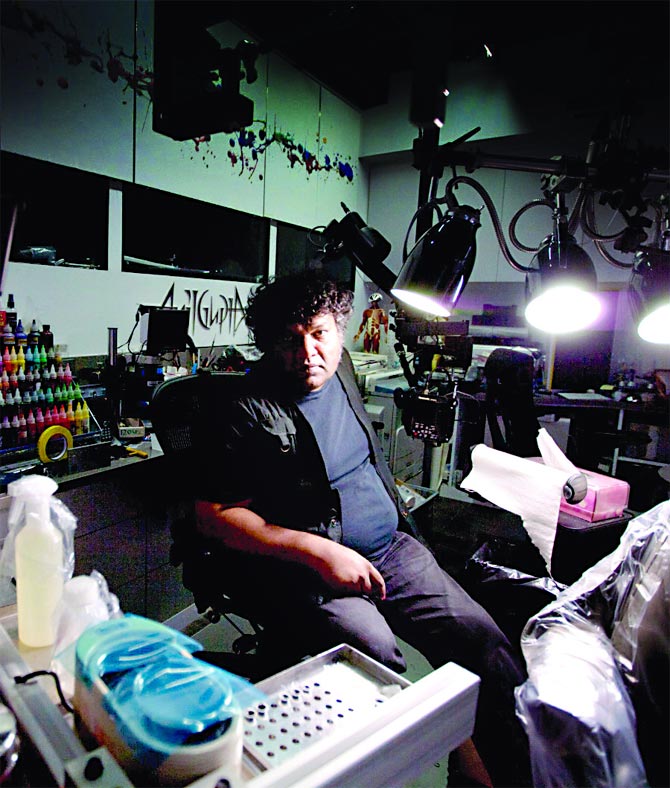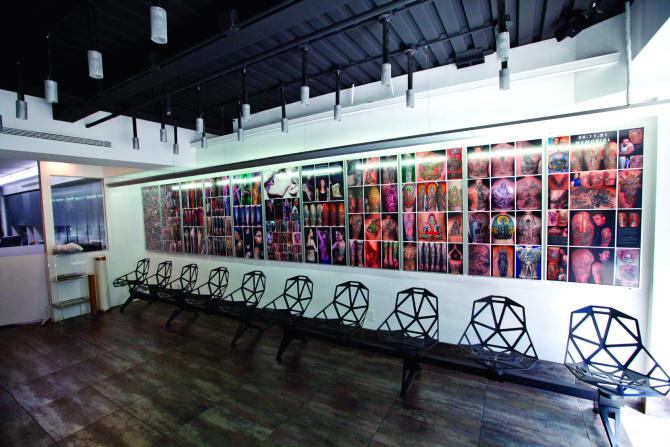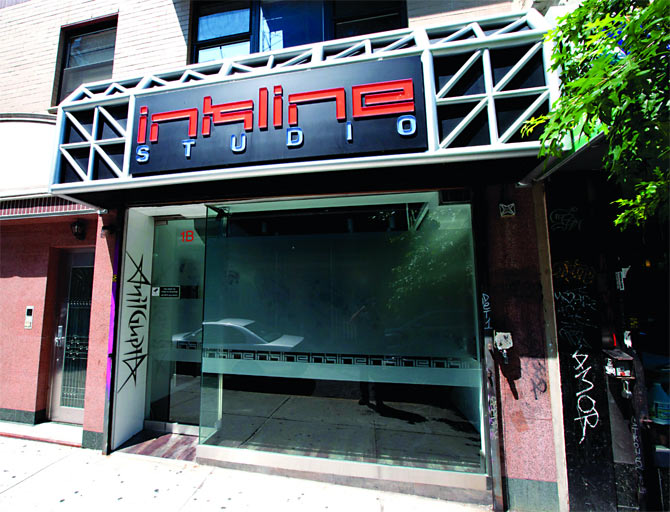Chaya Babu
Chaya Babu gets a peek into the inside world of Anil Gupta, one of the topmost inkers in the US.
What’s funny is that it’s in a spot that literally never shows, but will be visible in an Indian outfit, which I really only wear when I go places with my parents!” I say, referring to my months-old tattoo on my ribcage that I know my parents would abhor.
Neelam Gupta laughs at the irony of the allegedly hidden spot I chose.
“Man you’re tough,” says her husband Anil Gupta. “That area hurts! You took it like a real woman I guess.”
This is probably in the middle of our two-and-a-half hour-long aimless chat.
I’ve wondered, as the evening has worn on, all of us in the back of Gupta’s Lower East Side shop, INKLINE -- with Anil’s client, fellow artist Vincent Castiglia -- how I’ve managed to have such a rapport with a 50-year-old male tattooist from Mumbai, and how we’ve ended up talking about a range of issues that boil down to one thing essentially: Tradition.
I found Gupta because he’s Indian. Well, for these purposes anyway.
I had first found him as I researched places to go for my tattoo, and he was mentioned across the Internet as one of the country’s top inkers.
Well known for his reproductions of old master paintings among other seriously cool stuff, he was consistently ranked on the lists that count, and celebrities (even from outside New York) flocked to him.
His price range started at $450 an hour and he had a six-month waitlist.
I was in no real rush to get branded for life, but the price tag was a tad out of my range.
Still, as I scrolled through the options to ultimately settle on somewhere less famous, but clean and reputable, his name stuck out.
Who is this Indian tattoo guy? Obviously, I noticed.
Indian-ness, however, is not the common ground that has allowed such a seamless conversation to flow. And Gupta is vehement in his stance that his ethnic identity is incidental to his being; it doesn’t play a role in the work he does or the man he is.
That feeling is probably what’s forging the connection.
“I think I was sort of like, ‘Okay, all my life I’ve been trying to get out of that thing, and you’re pushing me back into that little space and drawing borders all around me,’” he explains, as we discuss the repeated frustrating experience of others emphasising Indian as defining trait of our paths or beings. “That’s where I have a problem with that type of thinking. You know what I’m saying? I’m trying to be broad-minded, and they narrow it down constantly.”
It’s not that surprising that someone who decided to make tattooing his life’s work is “broad-minded.” Most would go as far as to assume that such a person would be kind of a rebel. A radical.
For the time and place Gupta is from -- 1960s and 1970s Bombay -- it’s possible that that’s the case.
When he started out in India in 1982, he says, he was one of a handful of tattoo artists. Specifically, he recalls that number being four.
When he returned in 2010, there were more than 700 studios.
Tattoo culture has evolved in India. That’s the case on a global level as well, though, with everything from small symbols, illustrations, and words to full, elaborate sleeves becoming more and more visible. Perhaps this is a stretch, but they’ve almost become normal.
Gupta explains that the power of the global media and the contagion of Western ideals have meant that athletes, pop stars, models and actors sporting tattoos contributed to this shift on an international level.
“The level of acceptance in mainstream society has changed; the way we see tattooed people has changed dramatically,” Gupta says.
Why Anil Gupta is New York's top tattoo artist!
Chaya Babu
It’s pretty much part of the general scene these days. It’s no longer being hidden and pushed into the background. People showcase them and are proud to have them -- they’re considered part of your personality and individuality. That wasn’t the case before.”
“Before if you were tattooed, it was like you better hide that. Like, ‘Oh my god Chaya, who’s going to marry you? You’re a slut and a whore.’”
Another small burst of understanding laughter.
We all agree that this is something my mother, and those of her generation, still probably think. And if we are being fair, we get that it’s a big deal in their minds.
This brings us back to our discussion of old versus new, conventional vs modern, closed- vs open-minded.
We weave in and out of this overarching theme as Gupta creates a thick, scaly, thorned vine on Castiglia’s right forearm.
A texture that resembles the bark of tree is being etched into the skin, full of shading and depth and dimension. Gupta is drawing it over an older tattoo, and it’s working out pretty well considering the fact that I can’t tell what the layer beneath once looked like.
I learn that he’s using black and white ink and a needle that’s actually seven tiny needles.
Ouch.
“This is my guy. Anil is the master,” Castiglia says, his voice gruff and raspy. Fitting. In a way.
These words are coming from someone with quite a bit of acclaim himself. Castiglia is known for his tattoo art, but more for his realist paintings, which are made from human blood, and his work hangs in numerous renowned collections around the world.
Castiglia had Gupta design an ornate Gothic cathedral, created in the digital sculpting and painting software SBrush, for his neck, with the words ‘Life is Pain’ inscribed beneath.
Neither man can estimate how many hours Castiglia has spent in Gupta’s chair.
I’m getting a mini lesson on tattooing. Much more than I picked up as I stared through a window pane in SoHo while a bald guy engraved my side with Arabic lettering that translates to ‘ray of light.’
Gupta describes one of his own tattoos, a rendering of the four elements, earth, water, air, and fire, and mentions a few names as those responsible for what he calls the fusion tattoo: Paul Booth, Guy Aitchison, Filip Leu, Jack Rudy.
They are unrecognisable to me. But, according to Gupta, they are the pioneers.
“This is as high as it goes in the craft,” he says.
“Yeah, top dogs,” Castiglia adds. “And Anil is on that list. He just wasn’t tattooing himself.”
Can I see it?
“Ha!” Gupta doesn’t look up from his canvas. “I wouldn’t drop my pants right here!”
“Oh. That’s alright,” I say.
“Thank you.”
Gupat is holding a crumpled tissue in the hand that doesn’t have the needle in it. A mix of ink and blood collects in drops on Castiglia’s skin. Gupta wipes it away to see his progress more clearly. The thorns are long and sharp, bending to the curve of the arm. Oddly, they conjure for me an image of dark forbidden woods that surround an enchanted castle -- like in Disney’s Sleeping Beauty.
The references are ridiculous. So much for feeling kind of badass.
Why Anil Gupta is New York's top tattoo artist!
Chaya Babu
Asked how he does what he’s doing, Gupta talks about being keen and attentive to nature.
Together we look up and straight out the glass door at the front of the shop, to a tree planted in the New York City sidewalk just outside. He points out the translucency of the leaves, how the yellow sunlight filters through them to create a glowing effect. These are things he knows without looking.
He talks about subsurface scattering like explaining it to a 7th grader in science class.
“It’s observation I guess,” he says. “The way it’s possible for you to write and actually translate your emotions into words by having a very rich vocabulary -- you can be more articulate, and stretch the words and play with the words -- in the same way, my visual palette has to be very rich.”
His softness seems incongruent with what I decide is a fixed furrowed brow, heavy lidded eyes, and rough features. He is thick around the midsection and his cheeks show that. A faded black T-shirt with a graphic square print on the front hugs his belly. His mess of curly black hair is longish in the back, the graying sideburns extending downward.
He and Neelam are like the cool Indian parents that never existed when growing up.
They have a 19-year-old, Ria, who’s at Hunter College. There’s a large portrait of her and Neelam on the wall, probably taken a decade ago.
Gupta says that as a child, Ria never knew that her father’s work was different or interesting or not your run-of-the-mill family man job. To her, all daddies were tattoo artists.
Cute. And, in my opinion, highly fortunate.
Along with being open and liberal about something like their daughter getting permanent body art -- but not before she’s old enough to pay for her own and, even then, hopefully no names of boyfriends -- the Guptas are generally free-thinking and progressive and have raised Ria that way.
Can the same connection can be made about the emerging tattoo trend in India? Is the prevalence of young, upper-class urban women with strapless mini-dresses, shoulders stamped with flowers and the like, symbolic of a deeper type of liberation where females have real agency over their bodies -- not just the picture of it?
“I think it’s one fight at a time, one change at a time. And any change is a welcoming change,” he says.
“Are you comparing India to the Western world? Is that where you’re coming from?”
“I think within the context, and by Indian standards, it’s a big change. I’m actually celebrating the change. I’m looking at it positively and I’m not expecting things to change completely overnight.”
“I don’t say ‘changed’ in the past tense; I think it’s changing. And as long as it’s changing, we’re moving in a certain direction, right? Are we there yet? No. But then who the hell is? Nobody’s there. Let’s look through that point of view for a second.”
I have on my American-girl-in-Mumbai lens. But Gupta grew up there -- no matter how little he identifies with some outside standard of being ‘Indian,’ he still grasps the place and the culture and the issues. We’re talking about feminist things and his argument wins.
We are, however, aligned on one main truth, and that has been clear throughout our exchange, which has now lasted into dusk, the summer sun no longer making dancing shadows on the Rivington Street concrete: The Indian box is tight and narrow.
Not fitting makes you see the world differently.
He was annoyed at the thought that I’d be another Indian reporter asking him Indian questions that don’t pertain to him.
I’m scared that my mom will read this and demand to see the tattoo and cry or something.
We agree that to her it matters, that there’s lots wrapped up in the keeping my body unmarked. I bemoan the absurdity of it.
“I’m going to give you a word,” Gupta says, knowing I don’t speak a lick of Hindi. “Parampara.”
He waits, looking at me. I stare back, silent.
“TRADITION.”




Comment
article